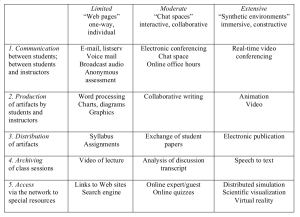http://lrs.ed.uiuc.edu/students/bweinert/304code.htm
Preamble states that ‘Not only must educators exhibit ethical excellence in how technology is used in their profession, but educators must instill the same standards in their students.’
I. Application of Technology
Standard 1. Educators shall use district technologies to improve the overall quality of the education they provide.
Standard 2. Educators shall follow the national, state, and district guidelines for infusing technology into their respective curriculum.
II. Access
Standard 1: Educators shall provide equal access to technology for all students.
Standard 2: Educators shall work to provide equitable technology resources to all students.
Standard 3: Educators shall use Internet filters and blocking software in the least restrictive manner possible where the students’ rights to access information without censorship are balanced with their safety and compliance with the federal Child Internet Protection Act (CIPA).
III. Guidelines for students
Standard 1: Educators shall provide an Acceptable Use Policy (AUP) to inform students of the appropriate use of district technologies.
IV. Intellectual Property
Standard 1 Educators shall respect the intellectual property of their peers.
Standard 2: Educators have a responsibility to teach their students about intellectual property.
V. Privacy and Confidentiality
Standard 1: Educators shall monitor student computer use in the least restrictive manner possible where the learners’ safety and privacy rights are balanced.
Standard 2: Educators shall provide general notice of various monitoring activities for all users.
Standard 3: Educators shall provide general notice of accessing and/or deleting of any users’ files.
Standard 4: Educators shall protect personal student information and maintain confidentiality of student records.
VI. Security
Standard 1: Educators shall use only those password-protected school accounts that have been assigned to them.
Standard 2: Educators shall respect the confidentiality of files and resources on district networks.
Standard 3: Educators shall have the responsibility of providing secure controls for all technology resources.
Standard 4: Educators shall report any breach in security to the director of technology, network manager, or other designated administrator.
VII. Maintaining Equipment
Standard 1: Teachers shall be responsible for maintaining the technology equipment that they use.
VIII. Community Relations
Standard 1: Educators shall involve the community in establishing a technological vision for their school district.
Rationale: The community surrounding a school district will be directly affected by the infusion of technology into the educational practice. Students will want additional access outside of the school building, which will impact their homes, other public institutions, and some of the local businesses. In addition, the students attending school will also become influential workers within the community both as part-time employees and potential full-time employees. Thus, the input from the community as to the needed technological knowledge and skills will be invaluable.
 “/…/ it is important that college administrators recognize this and support faculty members in their journeys to integrate instructional technologies, as Loui says “…not merely to duplicate conventional pedagogies, but to promote intellectual engagement.”
“/…/ it is important that college administrators recognize this and support faculty members in their journeys to integrate instructional technologies, as Loui says “…not merely to duplicate conventional pedagogies, but to promote intellectual engagement.”